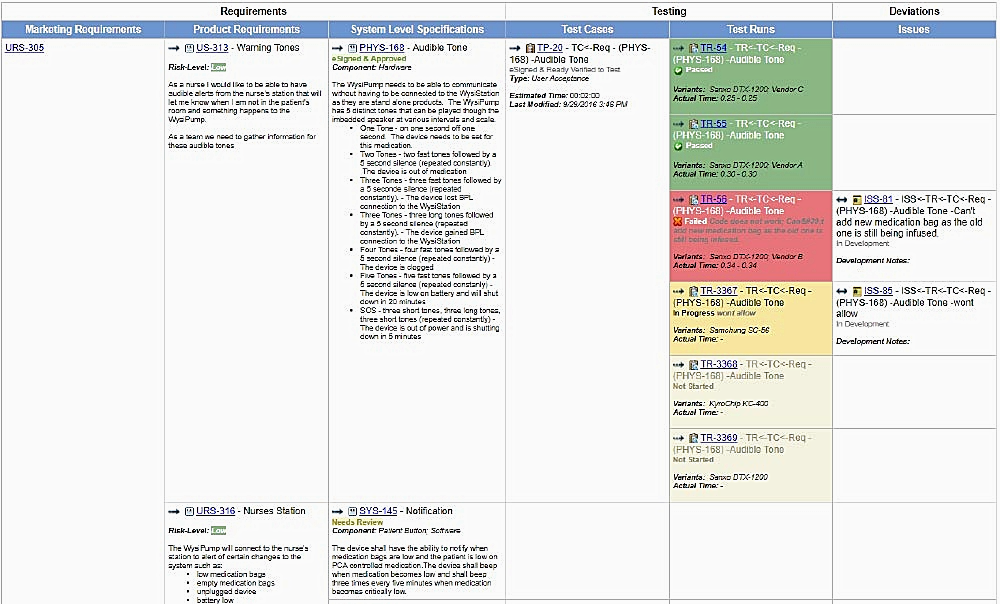Blog
February 23, 2023
Agile Requirements and Traceability
DevOps,
Security & Compliance,
Application Lifecycle Management
Agile has become one of the most widespread methodologies used in product development. As the Agile methodology has further developed, it’s become clear that Agile is meant to be adaptive. It should be used to make your development team more productive, not to limit your ability to accomplish your goals.
Still, there’s a learning curve — and persistent hesitation — in adopting Agile for teams that require documentation and traceability. Organizations in highly regulated industries that need to prove compliance and pass stringent audits may be the most hesitant to embrace Agile. Is it possible to create an Agile environment and stay compliant? Absolutely.
The key is finding the right tool—like Perforce ALM (formerly Helix ALM) — to achieve a hybrid approach that works for your unique needs. To do that, you must manage Agile requirements and traceability.
Agile Requirements
Traditional requirements gathering and documentation is done to ensure that the final product meets all expectations — which is especially important when compliance is a goal. Failing to provide accurate requirements can result in anything from project delays to project failure.
So, the question is how to translate traditional requirements into Agile requirements without losing necessary details.
When you look at the information that a product requirements document (PRD) defines — purpose, features, acceptance criteria, and timeline — it easily translates into Agile as user stories. You just need to rethink the process of creating and updating requirements to fit the Agile model.
Agile Requirements Gathering
In order to create requirements or user stories, you must define a process to collect them. Our blog on requirements gathering explains how to tweak your Waterfall requirements gathering to a more Agile process. But basically, we know that traditional requirements are gathered through:
- Brainstorming
- Interviews
- Review similar systems
- Observe the environment
- Talk to support teams
Understanding this flow of information, you can make that process more Agile by gathering requirements through a checklist that looks more like:
- Detail user stories with links
- Prioritize
- Track and communicate
- Use prototypes
- Use a requirements management tool
The Agile process is set to obtain the same information. You are just folding the process of detail collection into steps the Agile team understands.
Back to topHow to Manage Requirements in Agile
In Agile, user stories are shared via sticky notes or an interactive document, whereas a PRD created through a Waterfall process is relatively static. So, if you’re going to use requirements in an Agile way and ultimately incorporate traceability, you really need to use a requirements management or ALM tool that is equipped for hybrid workflows.
For example, Perforce ALM bridges this gap through task boards — interactive, alternate views of folder contents that look and function just like a physical task board. Folder items are displayed as cards in this virtual task board. Cards are organized vertically in columns mapped to your workflow, and horizontally in swim lanes by folder, user, relationship, or requirement document.
You can drag cards between columns to change item status as work progresses and perform other actions — such as creating new related items, entering hours, and viewing time-tracking information.
Ultimately, you’re able to create a user story that can be a part of your documentation set, while simultaneously appearing in your backlogs and sprints as required. You can also set work in progress (WIP) limits for each column to help identify bottlenecks. You can see how an ALM tool can take a more robust set of data and configure it to be used in an Agile way.
📘Related resource: Requirements Gathering Templates: Comparing Agile vs. Waterfall Techniques
Back to topEvaluating Requirements Management Solutions?
Get our Requirements Management Software Buyer's Guide to learn 5 questions to ask when comparing traceability and compliance solutions.
Traceability in Agile
Traceability refers to the ability to track and trace requirements to artifacts, test runs, and anything else in the product lifecycle. Tracing creates transparency and accessibility for every step of development, including who completed what tasks and when.
Requirements traceability is important because it lets you keep track of and record the history of any development artifact — which is often used to comply with regulations and minimize risk. In regulated industries, it is crucial. Traceability helps with a number of important things:
- Risk mitigation
- Quality control
- Ship or release speed
- Operational efficiency
- Proving (not just meeting) compliance
To see your traced items, you use a traceability matrix. This is a document that shows the relationship between requirements and other artifacts, proving that requirements have been fulfilled. It typically tracks requirements, tests, test results, and issues.
Below is an example of a traceability matrix created by Perforce ALM.

🤔 Do you have the right processes and tools in place to support compliance and risk mitigation?
Find out in our webinar, Align Your GRC Strategy to Meet Business Goals >>
How Do You Establish Requirements Traceability in Agile?
While you can create a traceability matrix manually, it demands constant attention and updates. So, if you want a traceability matrix in Agile, you cannot rely on Excel. It contradicts the entire purpose of the methodology. To get requirements traceability in Agile, you need an automated tool.
In a solution like Perforce ALM, you perform high-level requirements gathering in documents (where each paragraph is a traceable record). From there, create user stories — which can be automatically linked and added to backlog/sprints and to your document set at the same time. Perforce ALM will then automatically generate a requirements traceability matrix.
In other words, you maintain all of the information you need for compliance in the tool, which will automatically translate relevant information into an Agile workflow and link everything together in a traceability matrix.
Learn more about transitioning to Agile and maintaining traceability.
📘 Get the Guide: Transitioning to Agile in a Safety-Critical Environment >>
Back to top
Create Your Own Requirements Traceability Matrix in Agile
Adapting a new tool is a significant investment that requires careful evaluation. That’s why we offer a free trial of Perforce ALM for 30 days. Test it out — and see how easy it is to create your own Agile requirements traceability matrix.
GET MY FREE TRIAL
▶️ WATCH A DEMO FIRST

